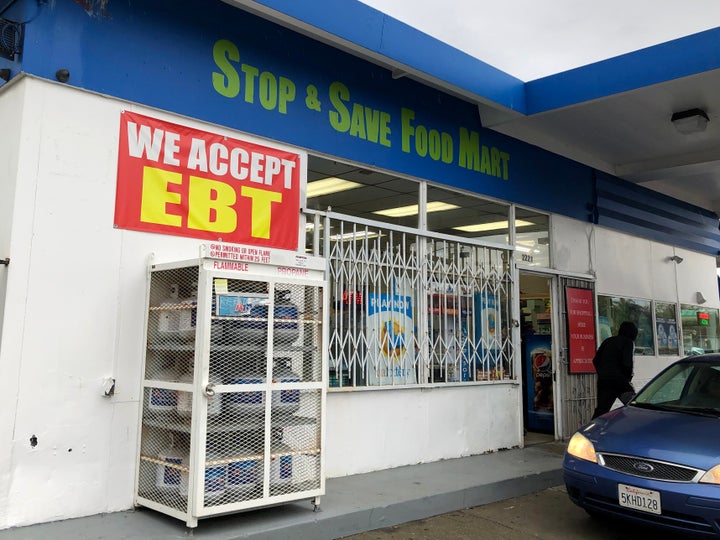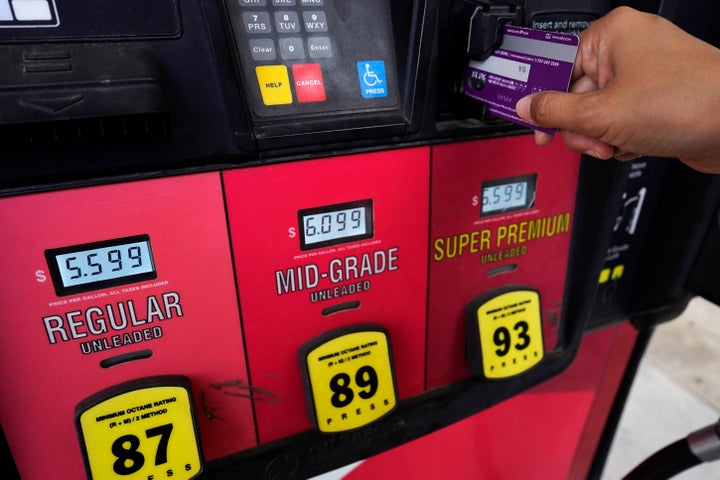
Last fall, Barbara went online to check the balance on the electronic benefit transfer card she used as a recipient of federal food assistance. She was devastated to see that more than $2,000 in benefits she’d saved to help feed herself and her four children had simply vanished.
“Everything was taken, just a couple of days before Thanksgiving,” recalled the New York City resident. “I’m with my kids so now I’m trying to hold it in, and then my tears just started coming down. They’re patting me on the back and telling me it’s OK. And I’m like, ‘What am I going to do?’”
Barbara, who asked to be identified by a pseudonym due to the sensitivity of the incident, is a victim of what anti-hunger advocates describe as a growing trend nationally: the theft of food and cash benefits from EBT cards via skimming.
Skimming is a process in which a thief attaches their own card reader to a retailer’s legitimate reader, allowing the swindler to steal information from users’ cards and later clone them. Since EBT cards lack the embedded microchip technology found on most credit and debit cards, they are particularly vulnerable to such attacks.
“My tears just started coming down. ... [My kids are] patting me on the back and telling me it’s OK. And I’m like, ‘What am I going to do?’”
- Barbara, a victim of benefit theft
National data is sparse, but legal aid and anti-hunger groups as well as government officials agree that 2022 saw a sharp uptick in skimming of federal food assistance. The Department of Agriculture, which oversees the Supplemental Nutrition Assistance Program funding the cards, issued a scam warning in October amid skimming reports in multiple states.
Between July 2021 and September 2022, Californians reportedly lost $29.7 million in direct cash assistance and $4.7 million in food benefits due to theft. Cash benefit theft from EBT cards in the state went from less than 1% in 2019-2020 to a projected 1.7% in 2022-2023.
Massachusetts, which advocates say was also hit hard, reported $1.6 million stolen from over 5,000 households between June and November 2022. In Maryland, more than $1.6 million was stolen between October 2022 and the end of February — compared with about $1.8 million between November 2020 and the end of 2022.
Such thefts have left thousands of food assistance recipients in precarious situations — even after lawmakers vowed to help them. Late last year, Congress approved funding to restore some benefits to victims of SNAP skimming, but little of that money has made it into their pockets.
The Ghost Of 1996′s Welfare Bill
In addition to EBT cards’ reduced security compared with bank-issued credit or debit cards, EBT cardholders have less legal recourse for regaining what they’ve lost after a theft.
Under a 1996 welfare bill signed by President Bill Clinton at the urging of House Speaker Newt Gingrich and other congressional Republicans, EBT cardholders are specifically exempt from certain protections that limit losses for credit and debit card holders.
“I teach a course on poverty law, and I am repeatedly struck by how many of the current challenges that we see in our public benefit system date back to welfare reform in the ’90s,” said Betsy Gwin, a senior attorney with Massachusetts Law Reform Institute, a nonprofit poverty law and policy program.
“It was not surprising that it went back that far, but it was quite frustrating to know that this is something that has been festering for so long,” she said.
“I am repeatedly struck by how many of the current challenges that we see in our public benefit system date back to welfare reform in the ’90s.”
- Betsy Gwin, a senior attorney with Massachusetts Law Reform Institute
The 1996 bill paved the way for states to replace paper food stamps with cards. Along with limiting fraud, the move aimed to reduce the stigma of being on food assistance, as other shoppers wouldn’t know if someone was using an EBT card or credit card to pay. But skimming victims are now facing the risk of public embarrassment once again.
“Imagine the experience when you have to swipe your card and find out that there’s only 70 cents left on your account, and you have to leave a whole cart of groceries in the checkout line,” Gwin said.
Advocates say the solutions are relatively simple: allow full replacement of lost benefits, put microchips in benefit cards, and change the law to give EBT cardholders the same rights as other cardholder victims of fraud.
Lawmakers haven’t gone quite that far yet, but Congress did decide to address the issue in December as part of its $1.7 trillion catchall spending bill. First, they made victims of SNAP skimming eligible for limited replacement benefits, if the fraud happened on or after Oct. 1.

They also said the USDA must require each state — as well as the District of Columbia, Guam and the U.S. Virgin Islands — to put together a plan for issuing replacement benefits and boosting security on their cards.
As of early April, the department had approved only five plans. Two states, Maryland and Vermont, were eligible to make reimbursements with federal money in March under their approved plans, while three other states had projected dates for making reimbursements later this year.
A USDA spokesperson told HuffPost that the department was working to approve plans from all the state and other agencies administering SNAP benefits across the country.
“While some state plans are able to be approved quickly, other plans may require additional development and support from [the USDA’s Food and Nutrition Service] to ensure that states are able to properly implement and adhere to the guidelines,” the spokesperson said.
That sluggish pace is part of what worries anti-hunger advocates.
Skimming victims may have to turn to relatives or buy things on credit to make ends meet, which in turn can leave them in a financial hole or dig one deeper. Barbara, the benefits recipient in New York, said in March that she was feeling lasting effects from the pre-Thanksgiving theft.
“I’m still actually $1,000 in debt in rent. Yeah, I’m just digging myself out as slowly as I can,” she said.
So far, the state plans that have been made public are “a little bit of a mixed bag,” said Gina Plata-Nino, the SNAP deputy director at anti-hunger advocacy group Food Research & Action Center.
Plata-Nino said there were concerns around states’ proposed timelines for replacing lost benefits and the standard of proof that skimming victims could face, such as an obligation to file a police report.
Advocates also worry about the level of lost benefits that victims can recoup. The December law specified that restored benefits had to be the lesser of either the amount stolen or the value of benefits allotted for the two months preceding the theft. That means victims who had saved up their benefits and lost more than two months’ worth would be reimbursed at the lower amount.
Stacy Dean, the USDA’s deputy undersecretary of food, nutrition and consumer services, said the federal government was doing what it could to address fraud.
“[The Food and Nutrition Service] continues to work closely with our state and federal partners, law enforcement, SNAP retailers and our EBT processors to protect SNAP participants and their benefits and combat fraud,” Dean said in a statement to HuffPost.
‘Should I Have Not Went To This Store?’
The main thing advocates want is for states to provide EBT cards with microchips. Credit and debit cards with chips have been adopted relatively quickly in the U.S., after banks held off for years due to implementation costs. Chip cards can still be cloned, but it’s difficult to do so.
Plata-Nino said putting chips in EBT cards was “an expense issue” for state agencies that distribute SNAP benefits. For banks and other financial institutions, chip-embedded cards can cost between $1 and $2 each to manufacture.
No state currently has chipped EBT cards, though that may change soon. California Gov. Gavin Newsom (D) has proposed spending $76.5 million over a three-year period to upgrade and enhance the security of its EBT system.
And Maryland’s legislature passed a bill Monday requiring EBT cards issued on or after Oct. 1 to have chips. It would also require the vendor making the cards to provide fraud alerts for EBT cardholders and allow them to limit their cards’ transactions.
At a hearing in February, a Maryland Senate committee heard from several victims of SNAP skimming and other electronic benefits theft.
One witness, Andre Simmons of Baltimore, said he, too, had seen his SNAP benefits stolen during the holidays.
“It was two days before Thanksgiving, and I was planning this good Thanksgiving meal. It put me in a very stressful situation,” he said.
When he asked for help dealing with the surprising theft of government food assistance and the difficulty in getting it replaced, he ran into another problem.
“A lot of people, family, they didn’t believe that it happened,” he said.
“Imagine the experience when you have to swipe your card and find out that there’s only 70 cents left on your account, and you have to leave a whole cart of groceries in the checkout line.”
- Betsy Gwin of Massachusetts Law Reform Institute
For Barbara, her theft experience left a mark psychologically.
She now changes her card’s personal identification number regularly, and she has drastically cut down on the number of places where she uses the card. She also thoroughly checks each ATM and point-of-sale terminal before use.
Barbara said she still sometimes wonders if she bears any blame for the times she used her card before the theft, like when she bought her fiance a cake.
“Those are the things that I was just sitting here thinking, should I have not went to this store or not went to that store?” she said.
She told HuffPost that she wished EBT cardholders were just treated like debit and credit card holders.
“Everyone should be treated fairly — low-income, middle-class, upper — everyone.”